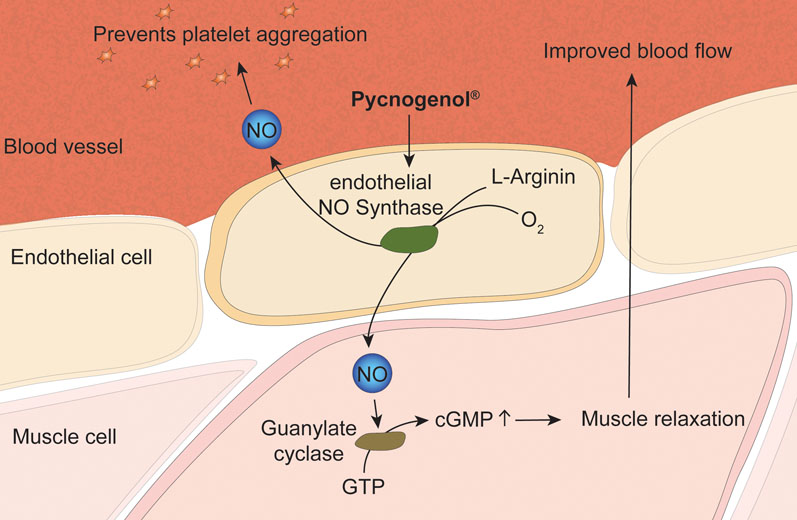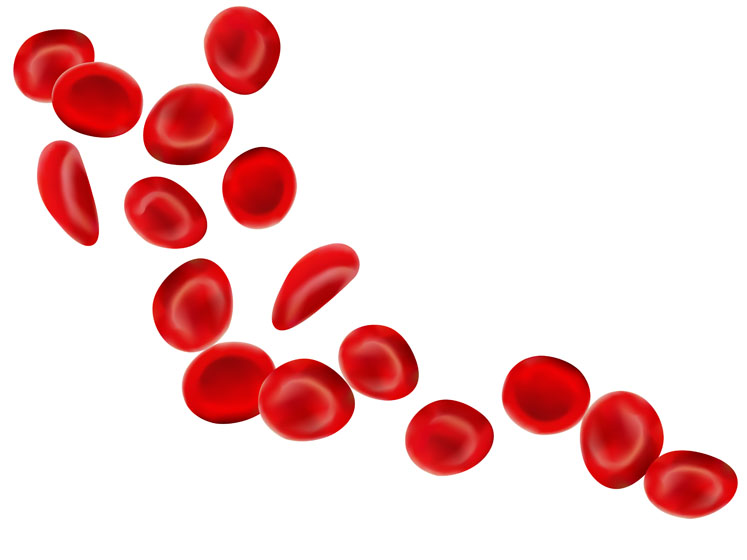A healthy cardiovascular system is key to maintaining vitality, physical strength and general well-being. The blood vessels within the cardiovascular system are lined with a thin layer of cells — the endothelium — that not only serves as a simple delimitation of the vessel wall, it’s also involved in many physiological functions.
The mediator molecule, nitric oxide (NO), is both formed in the endothelium and contributes to optimal blood flow by relaxing the blood vessels when needed.
In addition, NO helps to prevent platelet aggregation and thus reduces the risk of thrombosis.1 In addition, the endothelium regulates the exchange of substances between the blood and the body’s tissues.
When ageing or facing health problems such as high blood pressure, atherosclerosis or diabetes, the ability of the endothelium to produce NO diminishes.
Furthermore, the ability of the blood vessels to react to NO decreases.2,3 This may subsequently lead to a chronic narrowing of the blood vessels, which impairs blood flow, increases blood pressure and raises the risk of thrombosis.
Therefore, the endothelial system is key to the entire organism. Recent research results describe COVID-19 as an inflammatory disease of the entire endothelium (endotheliitis).
The SARS-CoV-2 coronaviruses attack the endothelial cells and can trigger inflammation and coagulopathies throughout the body, which may also be responsible for persistent post-COVID symptoms.4,5
NO production in the endothelium
As part of a healthy lifestyle, Pycnogenol — the original bark extract from the French maritime pine — can significantly improve endothelial health.
Many different studies have shown that Pycnogenol has a positive effect on endothelial functions, normalises blood pressure and reduces the tendency of blood platelets to aggregate.
An increasing number of clinical studies prove the effectiveness of Pycnogenol as a way to keep endothelial health problems at bay.6–12
Pycnogenol can increase the rate of endothelial NO synthesis from the precursor molecule L-arginine by stimulating endothelial NO synthase (eNOS). As a result, the blood vessel lumen is normalised and adequate tissue blood flow is ensured.6,7
It was found that a metabolite of Pycnogenol enters endothelial cells by facilitated absorption where it concentrates and can thus exert an anti-inflammatory effect directly in the endothelium (Figure 1).8

Figure 1: A metabolite of Pycnogenol enters endothelial cells and stimulates NO synthase
Clinical studies
In patients with coronary artery disease, the effect of Pycnogenol on endothelial function was investigated by measuring “flow-mediated dilation” in the artery of the upper arm.9
For this method, the expansion of the artery in response to an increase in the shear stress associated with blood flow is measured.
An 8-week randomised, placebo-controlled, crossover, double-blind study showed an improvement in flow-mediated dilation by 32% in the Pycnogenol group, whereas it deteriorated slightly in the placebo patients.
In another 12-week, randomised, placebo-controlled, double-blind study with high blood pressure patients who were taking the antihypertensive drug, nifedipine (a calcium channel blocker), the blood levels of endothelin 1 (a signalling molecule responsible for constricting blood vessels) were significantly reduced by 20% in the Pycnogenol group to reach healthy levels.10
In contrast, the concentrations of a vasodilator molecule (6-keto prostaglandin F1a) were increased to normal levels in Pycnogenol patients compared with placebo patients. This is a clear indication of improved endothelial function.

A third placebo-controlled double-blind study reported similar effects in type II diabetes patients with high blood pressure who took antihypertensive drugs (ACE inhibitors) together with 125 mg of Pycnogenol per day for 3 months.11
In this case, the endothelin-1 values in the blood were reduced to a healthy amount by 17.8%, whereas they were hardly changed in the placebo group.
In patients with borderline high blood pressure, elevated blood lipid levels and increased blood sugar levels, the flow-mediated dilation improved significantly after 8 and 12 weeks of Pycnogenol intake.12 These studies confirm the positive effects of taking Pycnogenol on endothelial function in patients with cardiovascular diseases.
Additional health promoting properties
In this context, additional health-promoting effects from regular Pycnogenol intake have been observed in numerous studies. Pycnogenol has been shown to improve microcirculation, to lower platelet aggregation by increasing endothelial NO production and to have strong anti-inflammatory effects.13–22
All these Pycnogenol studies regarding the improvement of endothelial function also offer good indications of possible positive effects on patients recovering from COVID-19.23
In a first pilot study that has just been published, it was shown that a regular 3-month intake of Pycnogenol can provide positive effects on some of the signs and symptoms associated with post-COVID-19.24
For example, a significantly improved endothelial function and increased microcirculation, as well as a reduction in inflammation markers, were found compared with the standard treatment.
References
- H. Strijdom, N. Chamane and A. Lochner, “Nitric Oxide in the Cardiovascular System: A Simple Molecule with Complex Actions,” Cardiovasc. J. Afr. 20(5), 303–310 (2009).
- M. Mudau, et al., “Endothelial Dysfunction: The Early Predictor of Atherosclerosis,” Cardiovasc. J. Afr. 23(4), 222–231 (2012).
- J.R. Sowers and M. Epstein, “Diabetes Mellitus and Associated Hypertension, Vascular Disease and Nephropathy,” Hypertension 26(6), 869–879 (1995).
- Z. Varga, et al., “Endothelial Cell Infection and Endotheliitis in COVID-19,” The Lancet 395(10234), 1417–1418 (2020).
- P. Libby and T. Lüscher, “COVID-19 is, in the End, an Endothelial Disease,” Eur. Heart J. 41(32), 3038–3044 (2020).
- D.F. Fitzpatrick, B. Bing and P. Rohdewald, “Endothelium-Dependent Vascular Effects of Pycnogenol,” J. Cardiovasc. Pharmacol. 32(4), 509–515 (1998).
- K. Nishioka, et al., “Pycnogenol, French Maritime Pine Bark Extract, Augments Endothelium-Dependent Vasodilation in Humans,” Hypertens. Res. 30(9), 775–780 (2007).
- K. Uhlenhut and P. Högger, “Facilitated Cellular Uptake and Suppression of Inducible Nitric Oxide Synthase by a Metabolite of Maritime Pine Bark Extract (Pycnogenol),” Free Radic. Biol. Med. 53(2), 305–313 (2012).
- F. Enseleit, et al., “Effects of Pycnogenol on Endothelial Function in Patients with Stable Coronary Artery Disease: A Double-Blind, Randomized, Placebo-Controlled, Crossover Study,” Eur. Heart J. 33(13), 1589–1597 (2012).
- X. Liu, et al., “Pycnogenol, French Maritime Pine Bark Extract, Improves Endothelial Function of Hypertensive Patients,” Life Sci. 74(7), 855–862 (2004).
- S. Zibadi, et al., “Reduction of Cardiovascular Risk Factors in Subjects with Type 2 Diabetes by Pycnogenol Supplementation,” Nutr. Res. 28(5), 315–320 (2008).
- S. Hu, et al., “Effects of Pycnogenol on Endothelial Dysfunction in Borderline Hypertensive, Hyperlipidemic and Hyperglycemic Individuals: The Borderline Study,” Int. Angiol. 34(1), 43–52 (2015).
- G. Belcaro, et al., “Diabetic Ulcers: Microcirculatory Improvement and Faster Healing with Pycnogenol,” Clin. Appl. Thromb. Hemost. 12(3), 318–323 (2006).
- G. Belcaro, et al., “Venous Ulcers: Microcirculatory Improvement and Faster Healing with Local Use of Pycnogenol,” Angiology 56(6), 699–705 (2005).
- M.R. Cesarone, et al., “Improvement of Diabetic Microangiopathy with Pycnogenol: A Prospective, Controlled Study,” Angiology 57(4), 431–436 (2006).
- R. Steigerwalt, et al., “Pycnogenol Improves Microcirculation, Retinal Edema and Visual Acuity in Early Diabetic Retinopathy,” J. Ocul. Pharmacol. Ther. 25(6), 537–540 (2009).
- S. Wang, et al., “The Effect of Pycnogenol on the Microcirculation, Platelet Function and Ischaemic Myocardium in Patients with Coronary Artery Diseases,” European Bulletin of Drug Research 7(2), 19–25 (1999).
- M. Araghi-Niknam, et al., “Pine Bark Extract Reduces Platelet Aggregation,” Integrative Medicine 2(2/3), 73–77 (1999).
- M Pütter, et al., “Inhibition of Smoking-Induced Platelet Aggregation by Aspirin and Pycnogenol,” Thrombosis Research 55, 155–161 (1999).
- R. Canali, et al., “The Anti-inflammatory Pharmacology of Pycnogenol in Humans Involves COX-2 and 5-LOX mRNA Expression in Leukocytes,” Int. Immunopharmacol. 9(10), 1145–1149 (2009).
- T. Grimm, et al., “Inhibition of NF-kB Activation and MMP-9 Secretion by Plasma of Human Volunteers After Ingestion of Maritime Pine Bark Extract (Pycnogenol),” J. Inflamm. (Lond.): doi: 10.1186/1476-9255-3-1.
- A. Schäfer, et al., “Inhibition of COX-1 and COX-2 Activity by Plasma of Human Volunteers After Ingestion of Maritime Pine Bark Extract (Pycnogenol),” Biomed. Pharmacother. 60(1), 5–9 (2005).
- F. Weichmann and P. Rohdewald, “Projected Supportive Effects of Pycnogenol in Patients Suffering from Multidimensional Health Impairments After a Sars-CoV-2 Infection,” Int. J. Antimicrob. Agents 56(6), 106191 (2020).
- G. Belcaro, et al., “Preventive Effects of Pycnogenol on Cardiovascular Risk Factors (Including Endothelial Function) and Microcirculation in Subjects Recovering from Coronavirus Disease 2019 (COVID-19),” Minerva Med. (2021): doi: 10.23736/S0026-4806.21.07650-3.




